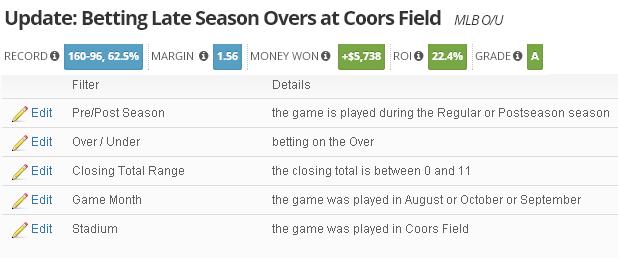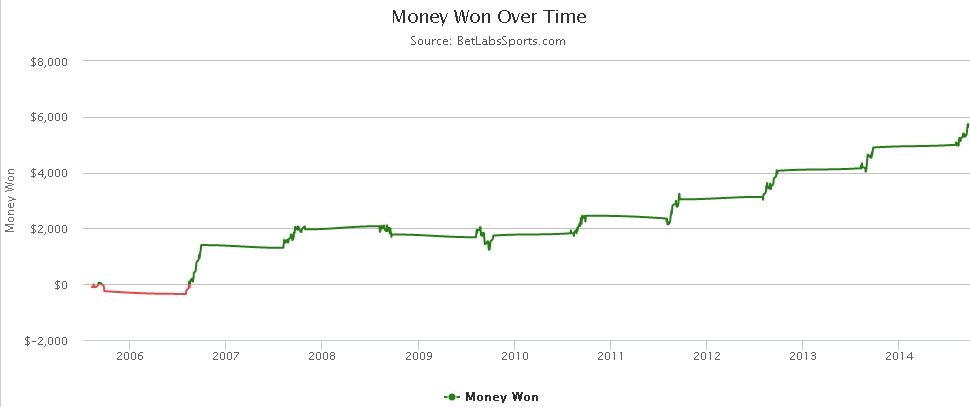
MLB Betting System: Late Season Overs at Coors Field
Last season after the All-Star break, we published an article examining how bettors could build their bankroll by taking overs at Coors Field. The Colorado Rockies ballpark is famous for being the most hitter-friendly stadium in baseball, and the main reason for these high-scoring games and lofty totals is the thin air in Denver.
Most people probably know that high altitudes create lower air density, but they may not realize the full effect of the mile-high air. Due to the reduced drag created by thin air, the ball travels significantly farther at Coors Field than it does at other stadiums. To be precise, baseballs in Colorado travel roughly 5% farther than at ballparks located at sea level.
While most fans may realize that hitters benefit from the mile-high air, they may not realize how lower air density adversely affects pitchers. Although baseballs move quicker in Coors Field, the air density can have an extremely detrimental impact on breaking balls. For example, a curveball is said to break approximately 20% less in Colorado as opposed to a ballpark located at sea level. That means that not only will a batted ball travel farther, but also that a pitcher with a huge curveball or sweeping slider will become far less effective.
While many breaking balls may look like beach balls to hitters at Coors Field, the average fastball actually drops significantly more at Coors Field. For this reason, the Rockies have traditionally targeted pitchers featuring plus fastballs, cutters, splitters and sinkers.
Starting in 2002, the Rockies began using a humidor to compensate for the fact that their home run rate was substantially higher than any other team in the league. The humidor makes the ball softer and heavier because they have absorbed additional moisture, but this has hardly affected the Coors Field advantage. As a team the Rockies are slashing .303/.357/.487 at home but have struggled with a .241/.289/.393 line on the road. Although home run rates at Coors have dropped since the humidor was first implemented, Colorado remains arguably the most hitter friendly destination in baseball.
We hypothesized that the over would be profitable at Coors Field but, knowing that humidity levels increase during the summer, we hypothesized that they would be particularly profitable during the late season. Our theory was quickly validated as we were able to create an over betting system which produced 129-79 record (+45.36 units) from 2005-2013. Although this system went 16-7 with +7.58 units last season, we wanted to make a few minor tweaks in order to maximize our profits.
By including postseason games and increasing the upper limits of our closing total range from 10.5 to 11 we were able to increase our overall units won from +52.94 to +57.38 without adversely affecting the return on investment (ROI).
Our new system also maintains the three most important characteristics of a winning betting system: strong driving hypothesis, large sample size and consistent year-to-year results. This system has had losing years in 2009 (16-16, -0.41 units) and 2005 (3-5, -2.48 units), but has otherwise seen steady gains each season. It has been particularly lucrative in recent years, posting a 52-22 record (+26.98 units) over the past three seasons.
To summarize, higher altitudes lead to a decrease in air pressure which causes less drag on the baseball. This decrease in drag causes the baseball to travel farther which explains why games are so high-scoring in Coors Field where the elevation is 5,280 feet. As humidity rises, that air density continues to decrease which amplifies this already significant trend.
Bet Labs users can receive all current game matches by copying this system from our Bet Labs Think Tank. Bettors can also view the latest MLB odds, scores, injuries, public betting trends and more by visiting our free MLB odds page.
Have any questions for the staff at Sports Insights? Utilize our live chat to speak with a customer service representative or e-mail us at help@sportsinsights.com.
David Solar is the Content Manager for Sports Insights and can be reached directly at David@sportsinsights.com.
9/22/15 Update: This system has gone 14-8 (+4.91 units won) during the 2015 season and is now 174-104 (+62.29 units won) overall.



Martin
07/31/2015 at 2:48 amNice article. Why have the closing total range as a filter? Any idea on results without it?
David Solar
07/31/2015 at 1:55 pmIt may seem basic, but the over has been historically more profitable in games with low totals while the under has been more profitable in games with high totals. By factoring out the highest totals (11.5+) we’re able to improve the ROI of our system. For what it’s worth, the over is only 9-12 (-3.39 units) when the total closes at 11.5 or higher.
Martin
07/31/2015 at 2:30 pmInteresting, thank you. FWIW when I read an article like this I’m thinking about in-sample fitting and ‘well chosen examples’ before I even start reading, so the more filters I see the less convincing I find the result. One of the reasons I particularly liked this article is the relative lack of filters used.
Max
08/15/2015 at 2:54 pmSo wait, you retroactively filtered out some of the results so your numbers look better? I don’t think that’s improving your system, that’s fudging the data.
David Solar
08/15/2015 at 3:00 pmLast season when we analyzed Coors overs we did not include closing totals of 11, however, when we went back to the drawing board this season we noticed that it had always been a profitable data point. We simply wanted to inform readers of the ideal range, and that should have included 11.
tom
08/03/2015 at 2:17 pmGood article but why you did not use – opening totals number – most of the totals at Coors field will go up not down – I think it would increase profits even more – because everytime you would bet with 0,5 lower total you would win/void more often….
David Solar
08/04/2015 at 8:08 amTypically we use closing numbers for our systems, in large part because users frequently aren’t able to grab that opening number. For what it’s worth, the system would have almost an identical record (161-97, +57.17 units won) if we examine opening totals of 11 or less.
Mike Spinasanta
08/05/2015 at 12:07 pmI wondered if there was any difference if you put in a day/night game filter.
David Solar
08/05/2015 at 12:28 pmIf the game was played at 6 PM Mountain Time or later (8PM ET), the system has gone 104-57 with +41.72 units won and a 25.9% ROI. Before that time, the system has gone 58-39 with +17.37 units won and a 17.9% ROI.
John
09/25/2015 at 3:47 pmHave the recent Coors totals been higher recently than earlier in the year or in past Septembers? Everything recently has been 11, even an 11.5 tonight.
David Solar
09/25/2015 at 3:55 pmCoors totals of 11.5+ by year
2005: 58
2006: 8
2007: 3
2008: 3
2009: 0
2010: 0
2011: 0
2012: 4
2013: 1
2014: 3
2015: 4
John
09/25/2015 at 4:26 pmNot sure if my previous comment went through. Have you noticed if the totals recently are higher than earlier in the year or previous Septembers? Seems like every total recently has been 11, and even an 11.5 today.
Dutch
04/12/2016 at 12:14 amAny numbers for early in the season before the humidity levels have picked up?
(Assuming humidity levels are lower in the spring time in Colorado than in summer. Which they might not be.)
Thanks.